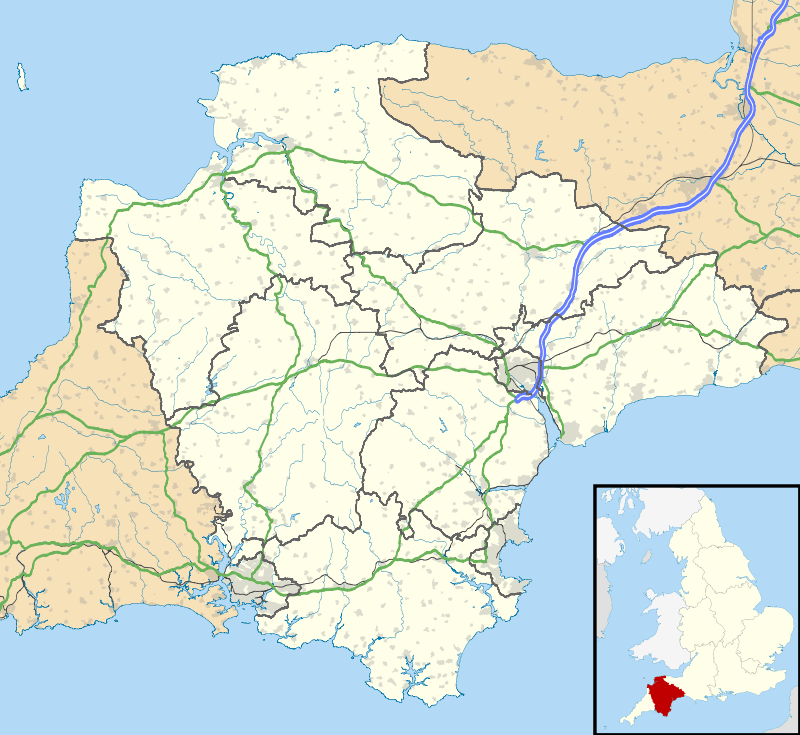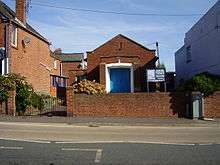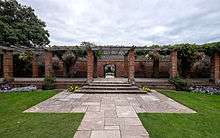Sidmouth
| Sidmouth | |
|---|---|
|
Looking east along Sidmouth Beach | |
 Sidmouth Sidmouth shown within Devon | |
| Population | 12,569 |
| OS grid reference | SY124874 |
| District | |
| Shire county | |
| Region | |
| Country | England |
| Sovereign state | United Kingdom |
| Post town | Sidmouth |
| Postcode district | EX10 |
| Dialling code | 01395 |
| Police | Devon and Cornwall |
| Fire | Devon and Somerset |
| Ambulance | South Western |
| EU Parliament | South West England |
| UK Parliament | |
Sidmouth /ˈsɪdməθ/ is a town situated on the English Channel coast in Devon, South West England, 14 miles (23 km) east-southeast of Exeter. In 2004, it had a population of about 15,000, of whom 40% were aged 65 or over.[1] By the time of the 2011 census the population was 12,569.[2] It is a tourist resort and a gateway to the Jurassic Coast World Heritage Site. A large part of the town has been designated a conservation area.
History

Sidmouth appeared in the Domesday Book as Sedemuda, meaning "mouth of the Sid".[3] Like many such settlements, it was originally a fishing village. Although attempts have been made to construct a harbour, none has succeeded. A lack of shelter in the bay prevented growth as a port.[4]
Sidmouth remained a village until the fashion for coastal resorts grew in the Georgian and Victorian periods of the 18th and 19th centuries. A number of Georgian and Regency buildings still remain.[5] In 1819, George III's son Edward, Duke of Kent, his wife, and baby daughter (the future Queen Victoria) came to stay at Woolbrook Glen for a few weeks. In less than a month he had died from an illness. The house later became the Royal Glen Hotel; a plaque on an exterior wall records the visit.[6] In 1874, Sidmouth was connected to the railway network by a branch line from Sidmouth Junction, which called at Ottery St Mary and Tipton St John. This was dismantled in 1967 as a result of the Beeching Axe.[7]
In 2008, a Canadian millionaire, Keith Owen, who had been on holiday in the town and planned to retire there, bequeathed the community's civic society, the Sid Vale Association, about £2.3 million upon learning that he had only weeks to live due to lung cancer.[8] The bequest was used as a capital fund to generate an annual interest dividend of around £120,000 for community projects.[9]
Geography

Sidmouth lies at the mouth of the River Sid in a valley between Peak Hill to the west and Salcombe Hill to the east. It is surrounded by the East Devon Area of Outstanding Natural Beauty and is on the Jurassic Coast, a World Heritage Site and the South West Coast Path. The red-coloured rock indicates the arid conditions of the Triassic geological period.
Erosion of the cliffs to the east of the river mouth remains a serious concern, threatening homes and the coastal footpath.[10][11]
The wide esplanade has been a prominent feature since Regency times. A series of southwesterly storms in the early 1990s washed away much of the shingle beach protecting the masonry. A series of artificial rock islands was constructed to protect the sea front, and tons of pebbles were trucked in to replace the beach.[12]
Transport
Sidmouth is 12 miles from the M5 at Exeter from Junction 30, Sidmouth is then accessed by the coast road A3052. A regular bus service is run to the town from Exeter up to every half-hour by Stagecoach, the bus then carries on to Honiton or Seaton on an hourly basis. [13] Since the closure of the Sidmouth Railway in 1967, the nearest railway stations are Feniton, Honiton or Whimple, all on the West of England line. Feniton is the closest of these stations, being eight miles away.[14]
Government
Sidmouth has its own town council, presided over by a chairman elected from councillors. There are eight wards, with 19 councillors in all. The town clerk is the senior paid officer with a team of full-time and part-time staff. The town is responsible for many of the locally run services including the information centre. Sidmouth lies within the areas of East Devon District Council and Devon County Council. The electorate of the Sidmouth ward at the 2011 census was 13,737.[15]
Sidmouth was in the Honiton parliamentary constituency from its recreation in 1885 until its abolition in 1997, since when it has been in the East Devon constituency.
Culture



Churches and museums
The parish church is dedicated to St Giles and St Nicholas. It was rebuilt in 1860; the architect was William White. Of the medieval structure, only the 15th century tower has been retained. Oddments of Norman and later stonework were included in the rebuilding. Features of interest include the reredos by Samuel Sanders Teulon and the Duke of Kent Memorial Window which Queen Victoria gave in 1867. Parts of the original fabric, such as the windows, were reused by the historian Peter Orlando Hutchinson in building a folly adjoining his house. He was also responsible for saving the stained glass in the vestry.[16][17] The folly is the Old Chancel in Coburg Terrace which was started by Hutchinson in 1859, in protest over the destruction of the original church fabric during rebuilding.
The museum, next to the church, has local memorabilia, historical artefacts, and geological samples.[18]
The church of All Saints, also Anglican (Taylor, architect, 1837), is in the Early English style with lancet windows and "oddly clumsy" pinnacles.[19] There were also Unitarian, Wesleyan (later Methodist) and Congregational chapels; the Unitarian chapel was founded in the 17th century by Presbyterians and the Wesleyan and Congregational ones in 1837 and 1846 respectively.[20]
Sidmouth is home to the Norman Lockyer Observatory and Planetarium, located on Salcombe Hill. The facility, completed in 1912, fell into disuse but was saved from demolition by the appeals of enthusiasts to East Devon District Council. The observatory now operates as a science education project and is open to the public.[21]
Music
Folk Week
Sidmouth Folk Week is an annual folk festival in early August attracting musicians and visitors. It became less financially viable over the years and in 2005 the last of the commercial sponsors, essential for its existence, pulled out. To continue the tradition, individuals grouped together to form Sidmouth FolkWeek Productions, a limited company. Since the change of format, the event has been held on a smaller scale, with no arena at the Knowle, though marquees are still erected in the Blackmore Gardens and The Ham at the eastern end of the town. The popular late night extra feature is also run at Bulverton on the edge of Sidmouth next to the main campsite.
Sidmouth Town Band
During the summer, Sidmouth Town Band, a brass band, play a series of concerts in the Connaught Gardens each Sunday at 8pm from late May until early September. The earliest record of the band is from a photograph of 1862.[22][23]
In 2010, during competition, it was crowned West of England Champion in the third section. It went on to win third prize at the national finals of Great Britain.[24] In 2011, it retained its West of England Champion title, becoming one of only a handful of bands to win back-to-back titles, and was promoted to the second section from 2012.[25] From 2017 the band was promoted to the First Section.
Literary associations
Sidmouth has featured in various literary works, e.g. as "Stymouth" in Beatrix Potter's children's story The Tale of Little Pig Robinson (1930) in which the author included views of the beach and other parts of the Devon countryside. In Thomas Hardy's Wessex it is the inspiration for "Idmouth". "Baymouth" in William Makepeace Thackeray's Pendennis, and "Spudmouth" in The Merry Adventures of Robin Hood by Howard Pyle, are both based on the town. In G. A. Henty's book "With Wolfe in Canada" the hero James Walsham is from Sidmouth and parts of the book take place there at the beginning and end. The poet Elizabeth Barrett lived in the town from 1832 until 1835.[26]
Sidmouth has been the setting for television shows, most recently an ITV adaptation of Agatha Christie's Marple in summer 2005.
It was a favourite spot for Sir John Betjeman. He chose it as the subject of the first programme of the television series John Betjeman in the West Country that he wrote and presented in 1962, The script takes the form of an extended poem and was republished in 2000 as a short book.[27]
Also in 1962, R F Delderfield had a house built on Peak Hill in Sidmouth. The house still exists and is called the 'Gazebo'.
Sidmouth, specifically the area of rock pools around Jacobs' Ladder, is also used as the location for H. G. Wells' The Sea Raiders.
Miscellaneous
The Sidmouth Herald is the local newspaper.
Manor Pavilion houses an arts centre and a theatre that hosts both amateur and professional productions.[28] There is also the Radway Cinema.[29]
Sidmouth has been a frequent winner of Britain in Bloom awards. Most recently it won the Small Town category in 2001 and the Coastal Resort category in 2005.
The Sid Vale Association, the first civic society in Britain, was founded in 1846 and is based in Sidmouth.
In 2016, a worldwide architectural competition was held in the town to provide ideas for the future redevelopment of Sidmouth's eastern town and seafront. The competition was initiated by Sidmouth Architect Henry Beech Mole.[30][31]
Twin towns
Sidmouth is twinned with Le Locle in Switzerland.
Features
The Esplanade
The Esplanade is the sea front road from the red cliffs of Salcombe Hill in the east towards Jacob's Ladder beach at the west Peak Hill can be seen in the distance.
Jacob's Ladder and beach
Jacob's Ladder is a series of wooden steps leading up to Connaught Gardens from Jacob's Ladder beach and its red cliffs.
Connaught Gardens

Connaught Gardens date from around 1820. They were named after the Duke of Connaught, the third son of Queen Victoria and he officially opened the gardens in 1934, aged 84. The bandstand there is used by bands in many weeks of the summer season.
Peak Hill Slope
This grassy slope up and along Peak Hill follows the red cliffs above Jacob's Ladder Beach. It provides a wide view eastwards over the whole town towards Salcombe Hill beyond it.
Economy
The principal revenue is from tourism, with a wide range of hotels, guest houses as well self catering accommodation in the local area.[32] Sidmouth is a retirement location, so pensioner spending is another source of income.
The largest employer is the East Devon District Council, whose headquarters are at the former Knowle Hotel. There is a large independent department store, Fields of Sidmouth, which has been on the same site for over 200 years.[33] There are pubs, restaurants, coffee houses and tea rooms. Also an indoor swimming pool, a sports hall at the leisure centre and a golf course.
Education
Sidmouth College is a comprehensive school which takes children aged between 11 and 18 from as far afield as Exmouth and Exeter.[34] In February 2012, with 852 pupils on the roll, the college was deemed 'Good' by Ofsted, .[35] The judgment of improvement in the college's provision followed the previous inspection (May 2009) when it was deemed 'satisfactory'.[36] In the 2005 Ofsted report, when there were 869 students on the roll, it was also deemed 'satisfactory'.[37]
Sidmouth College is situated in the Sid Valley. It admits students from East Devon.
There is one state junior school, which takes children from between the ages of 8 and 11. There are two state infant schools. There is, additionally, a private school : St John's International School (formerly known as the Convent of the Assumption) which takes children from two to 18, including overseas boarders. In 2007, it was taken over by International Education Systems (IES).[38]
Sidmouth International School is an English language school for foreign pupils.
See also
References
- ↑ "Area: Sidmouth CP (Parish). Parish Profile – People". Neighbourhood Statistics. Office for National Statistics. 28 April 2004. Retrieved 3 September 2012.
- ↑ "Town population 2011". Retrieved 24 February 2015.
- ↑ Millward, Roy; Robinson, Adrian Henry Wardle (1971). The South-West Peninsula. Macmillan. p. 175.
- ↑ "THE SIDMOUTH HARBOUR COMPANY OF 1836". The Industrial Railway Record. Retrieved 18 August 2016.
- ↑ Travis, John F. (1993). The Rise of the Devon Seaside Resorts, 1750-1900. University of Exeter Press. p. 112. ISBN 978-0-85989-392-3.
- ↑ Gardner, Suze (7 March 2016). The A-Z of Curious Devon. History Press. p. 148. ISBN 978-0-7509-6410-4.
- ↑ Holland, Julian (2013). Dr Beeching's Axe: 50 Years on : Illustrated Memories of Britain's Lost Railways. David & Charles. p. 37. ISBN 1-4463-0267-9.
- ↑ "Banker Keith Owen leaves Sidmouth £2.3m and a 'million flowers'". BBC. 29 August 2013. Retrieved 18 August 2016.
- ↑ "Man left town his £2.3m inheritance to plant a million daffodils". Metro. Retrieved 18 August 2016.
- ↑ "Devon County Council – Market Town Focus – Sidmouth". Devon County Council. Retrieved 2 October 2009.
- ↑ "Protect Alma Bridge plea from Sidmouth Chamber of Commerce". Sidmouth Herald. 2 August 2009. Retrieved 2 October 2009.
- ↑ Simm, Jonathan; Cruickshank, Ian (1998). Construction Risk in Coastal Engineering. London: Thomas Telford Publishing. ISBN 0-7277-2686-2.
- ↑ "Page not found". stagecoachbus.com. Retrieved 4 April 2018.
- ↑ "Distance between Sidmouth, UK and Feniton Station, Feniton, Honiton, UK (UK)". distancecalculator.globefeed.com. Retrieved 4 April 2018.
- ↑ "Wards total population 2011". Retrieved 24 February 2015.
- ↑ Mee, Arthur (1938) Devon. (The King's England.) London: Hodder & Stoughton; p. 390
- ↑ Pevsner, N. (1952) South Devon. Harmondsworth: Penguin; p. 262
- ↑ Museums, Devon. "Page Not Found - Devon Museums - The home of Museums in Devon". Devon Museums. Retrieved 4 April 2018.
- ↑ Pevsner, N. (1952) South Devon. Harmondsworth: Penguin; p. 263
- ↑ White's Devonshire Directory of 1850; Sidmouth in Genuki; retrieved 24 August 2012
- ↑ "Welcome to the Norman Lockyer Observatory". www.projects.ex.ac.uk. Retrieved 4 April 2018.
- ↑ "About Us". Sidmouth Town Band. Retrieved 18 March 2018.
- ↑ Farr, Ray. The Distin Legacy: The Rise of the Brass Band in 19th-Century Britain. Cambridge Scholars Publishing. p. 148. ISBN 978-1443842402.
- ↑ "Results: 2010 West of England Regional Championships | 4barsrest.com news". 4barsrest.com. 13 March 2010. Retrieved 24 August 2012.
- ↑ "Results: 2011 West of England Regional Championships". 4barswest. 12 March 2011. Retrieved 11 August 2013.
- ↑ Hahn, Daniel; Robins, Nicholas (2009). "Sidmouth". The Oxford Guide to Literary Britain & Ireland. Oxford University Press. ISBN 9780191727825.
- ↑ Betjeman, John (2000). Still Sidmouth: the Lost Poem. Ottery St Mary: Peretti Publishing. ISBN 978-0-906038-09-3.
- ↑ "Manor Pavilion Sidmouth". www.manorpavilion.com. Retrieved 4 April 2018.
- ↑ "Scott Cinemas". www.scottcinemas.co.uk. Retrieved 4 April 2018.
- ↑ "Ideas contest announced for Sidmouth". architectsjournal.co.uk. Retrieved 4 April 2018.
- ↑ Sumner, Stephen. "'Blue-sky thinking' in Sidmouth architecture competition". sidmouthherald.co.uk. Retrieved 4 April 2018.
- ↑ http://www.devon.gov.uk/tourism_trends_2005.pdf
- ↑ Fields archives
- ↑ "comprehensive school - East Devon". Sidmouth College. Retrieved 4 April 2018.
- ↑ "Ofsted 2012".
- ↑ "2008 ofsted report" (PDF). ofsted.gov.uk. Retrieved 4 April 2018.
- ↑ "2005 ofsted report" (PDF). ofsted.gov.uk. Retrieved 4 April 2018.
- ↑ IES Magazine 2007 – News Archived 22 December 2007 at the Wayback Machine. (pdf)
External links
| Wikimedia Commons has media related to Sidmouth. |
- Official Sidmouth Tourism and Town Website
- Sidmouth Town Council
- Sidmouth at Curlie (based on DMOZ)
- Rock fall at Pennington Point near Sidmouth February 2009 British Geological Survey
| Wikivoyage has a travel guide for Sidmouth. |
